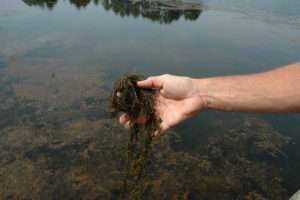Summertime pond management requires planning and caution

Phone calls about out-of-control aquatic vegetation are a common midsummer occurrence, said Texas A&M AgriLife Extension Service wildlife and fisheries specialist Dr. Billy Higginbotham.
However, he said, pond owners should proceed with caution when treating aquatic weeds in ponds where fish are important resources.
Higginbotham said thinning or eradicating aquatic vegetation can improve the overall environment for the pond and increase the pond's utility for recreation, livestock watering and/or irrigation. However, in larger ponds managed for largemouth bass and appropriate forage species, some degree of aquatic vegetation coverage may provide beneficial habitat and harbor food items.
Because of potentially extensive coverage, there are dozens of native and invasive species of aquatic vegetation that cause ecological and economic impacts throughout Texas, he said. And positive identification is the key to successful control of aquatic vegetation.
"I recommend people use the AgriLife Extension website aquaplant.tamu.edu for assistance in identification and control recommendations," Higginbotham said. "There is a wealth of information available to help guide landowners."
The site assists with identification including descriptions and photos and also provides treatment advice, such as whether biologic controls are available and gives multiple herbicide options, their effectiveness and how to calculate the area and volume of ponds for applications.
Higginbotham said landowners should treat ponds in stages if maintaining fish populations is important. Treating an entire pond with herbicides during the hotter months can create an oxygen debt, due to decomposing vegetation, especially algae and other submerged vegetation, and cause fish losses.
"This is typically a summertime problem because water at higher temperatures holds less oxygen than would be possible at cooler temperatures," he said. "If treatment is necessary during the heat of the summer, break the pond up into sections and treat only 15-20 percent of the pond at a time with one week in between treatments."
Higginbotham said lower water levels typically found in late summer can also aid landowners who want to renovate their ponds. Reduced volume of water requires fewer treatment chemicals to remove the existing fish population, which might include undesirable species, in order to establish and support fish species that offer better angling opportunities.
"Landowners with unbalanced fish populations may also want to remove existing fish populations and start over, especially in smaller ponds less than one surface acre in size that lend themselves more for the management of single species that accept a pelleted ration, such as channel or blue catfish, hybrid stripers or hybrid sunfish," he said.
Removal of existing species not easily managed in these smaller ponds, or that will compete directly with the desired fish species or in some cases prey directly upon stocked fingerlings, can be accomplished using rotenone.
Rotenone is a restricted use pesticide, therefore pond owners need a Texas Department of Agriculture pesticide applicator license to purchase and use, or must hire a licensed applicator, Higginbotham said.
The liquid formulation of rotenone is easier to use, Higginbotham said, because it mixes easily with water and can be applied by pump or by mixing into the prop wash of a small outboard motor. Protective gear should be worn during the application process including eyewear, gloves and long sleeves to avoid skin contact with the pesticide.
Rotenone prevents the fish from taking oxygen from the water. Fish should begin surfacing within 30 minutes of the application, depending on species. The fish, however, cannot be consumed because the U.S. Environmental Protection Agency has not established residue levels for rotenone.
Landowners should wait at least two to three weeks to restock the pond after the rotenone application, he said. It is safe for livestock to consume water that has been treated with rotenone, except for swine.
More information: Rotenone: Its Use in Fisheries Management. agrilifecdn.tamu.edu/fisheries … eries-Management.pdf
Provided by Texas A&M University



















